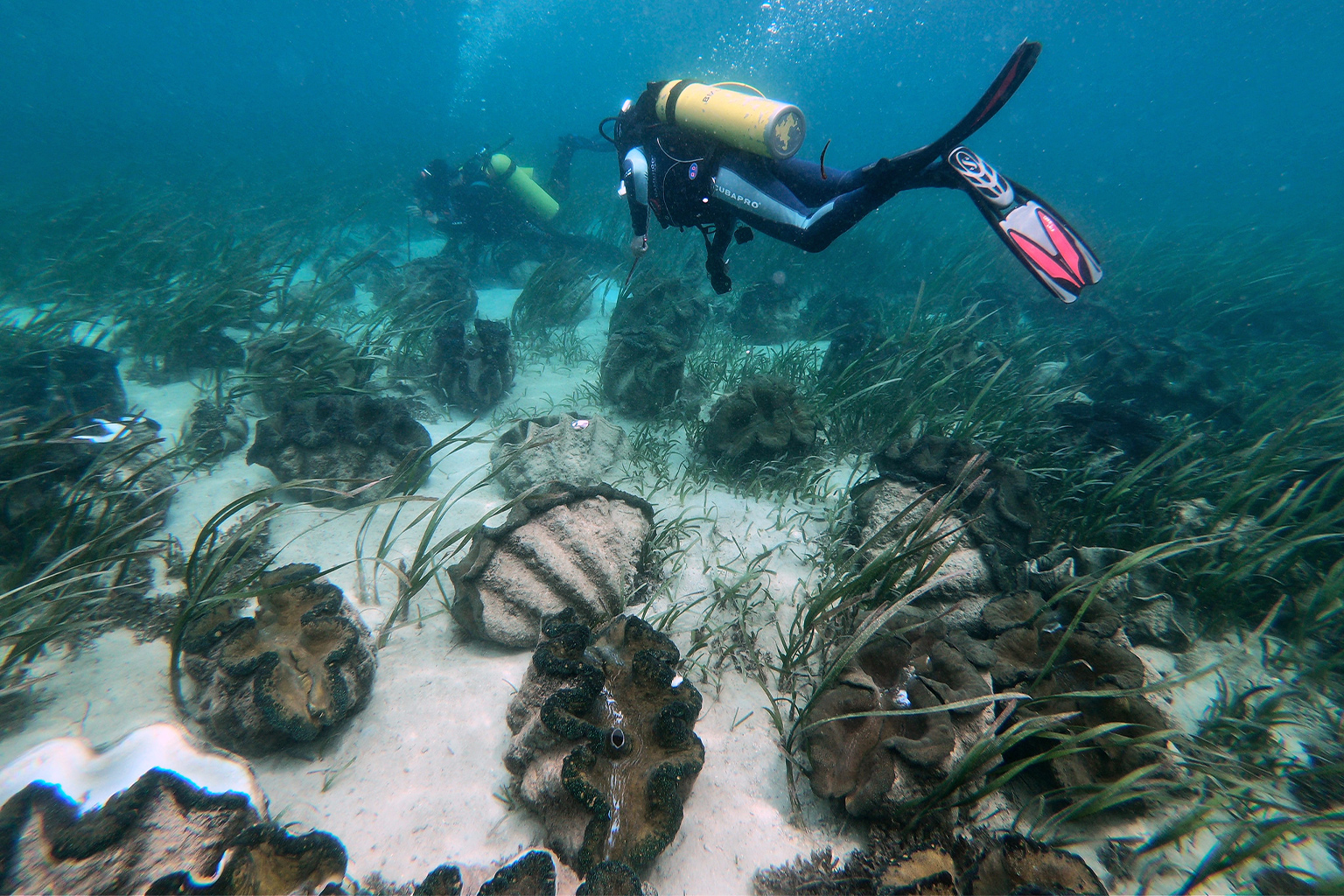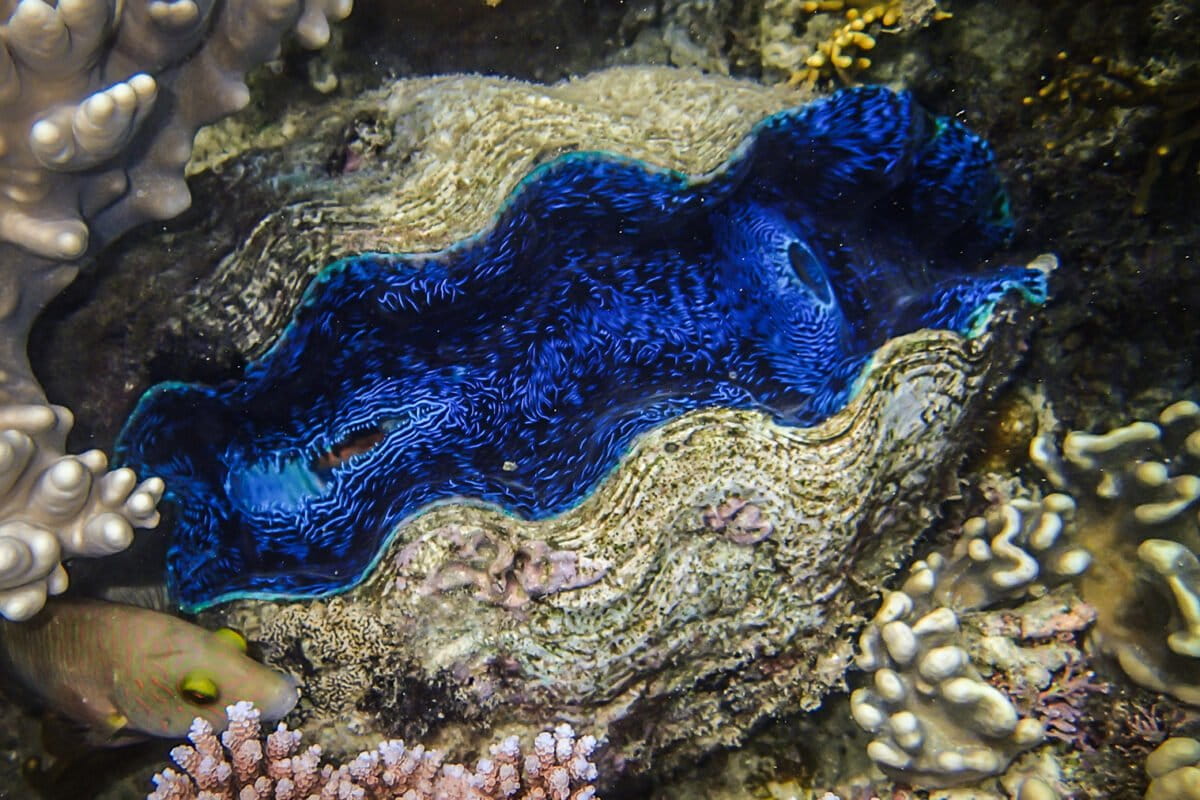- Giant clams, which can grow to weigh more than 200 kilograms (440 pounds), have long been traded for their shells, which are carved into decorative items, as well as for food and the aquarium trade.
- An analysis by the NGO TRAFFIC has found that giant clams are threatened by “both a sizeable legal trade and a parallel illegal trade that is much larger than we know.”
- TRAFFIC identified the Philippines as a hotspot of the illicit trade giant clam shells, accounting for more than 99% of all seizures linked to Southeast Asia despite laws prohibiting their harvest or trade.
- The NGO has called on governments to more closely monitor the trade in giant clams, and to scale up investigations into the networks that facilitate the illegal trade.
The Philippines, a hotspot of marine biodiversity, has emerged as the global epicenter of an illicit trade in giant clams that threatens the survival of these massive sea creatures.
According to a report published by wildlife trade monitor TRAFFIC, the country accounts for 99.7% of the 121,391 metric tons of giant clams seized in trafficking incidents linked to Southeast Asia during the past two decades.
Analyzing open-source media reports, published scientific literature and government records from January 2003 to December 2022, TRAFFIC noted that the Philippines accounted for 121,071 metric tons or nearly the entire volume of sequestered giant clams destined for the illegal trade during the assessment period. Other suspected origin countries included Indonesia, Thailand, China and Vietnam.
The clams confiscated in the Philippines, mostly fossilized Tridacna gigas, resulted from 71 seizures, 44 of which occurred in the western island province of Palawan, where this largest of all living giant clam species inhabits the wild.

The volume spike is attributed to 120,000 metric tons of giant clams netted in the Philippines’ southern city of General Santos on Mindanao Island in 2019. It’s the world’s biggest bust so far, prompting calls for authorities to probe the nature and demand of global trafficking of the giant clams, which help maintain coral reef health, abundance and diversity.
While harvesting fossilized shells doesn’t directly result in deaths of clams, it still presents ecological concerns, Rama Wong, TRAFFIC’s senior wildlife crime analyst and co-author of the assessment, explained by email. “Shell collection methods, especially in massive volumes, could disrupt or alter the marine environment and its inhabitants.”
The clear presence of a massive and ongoing trade also indicates a threat to live clams, Wong said. “These figures are worrying given that scientific findings from over a decade ago already pointed to declining giant clam populations and some species becoming functionally extinct in some range countries.”

A little-documented trade
Despite having long been harvested both legally and illegally for food, as decorative items, and for the aquarium trade, little is known about the global trafficking of giant clams.
Since 1985, 10 of 12 giant clam species have been listed under Appendix II of CITES, the international convention on the wildlife trade. Inclusion in Appendix II requires countries to report and regulate international trade of the species in question, but TRAFFIC’s review of documentation of the legal international trade in giant clams revealed major discrepancies. From 2003 to 2021, importers reported trade in more than 4 million giant clam shells, while exporters only reported 3 million shells traded.
This discrepancy could be due to poor reporting to CITES, or it “may be due to differences in units or taxonomic level used, or specimens being exported at the end of one year but only received by the importer the following year,” Kanitha Krishnasamy, TRAFFIC Southeast Asia director, told Mongabay via email.
“This impacts a country’s ability to understand the level of trade the country is involved in, to properly monitor and regulate trade and ensure that trade is indeed legal and sustainable,” Krishnasamy said. “TRAFFIC urges countries involved to take a closer look at how their data is recorded and reported. This can be used to identify any loopholes in the law and allow for greater scrutiny of the legal trade processes to ensure they are not being exploited.”
The vast difference in shell sizes, depending on the age and species of clam, and the variety of reporting methods also make it difficult to compare data across countries or between the legal trade and seizures of trafficked clams. The quantity of shells recovered by law enforcement has been reported in units ranging from shells to sacks to tons.
“What is clear is that giant clams, which are already under pressure, must contend with both a sizeable legal trade and a parallel illegal trade that is much larger than we know,” Wong said.

Indications of organized crime
TRAFFIC said the large seizure volumes suggested the involvement of organized criminal groups. Safeguarding giant clams against illegal catch and trade, the group said, requires identifying and prosecuting the perpetrators. “Without closer monitoring, giant clams could be depleted before the world even recognised the problem existed,” the authors said in a statement.
In the Philippines, giant clams are classified as threatened, and commercial harvest and trade are therefore banned under the country’s wildlife conservation law. Efforts to amend the law by increasing penalties to discourage violations, and adding provisions that allow authorities to go after organized wildlife crime syndicates have been underway for the past few years.
“Until now, we’re doing case buildup and profiling of illegal wildlife groups operating in Palawan,” said John Vincent Fabello, spokesperson for the Palawan Council for Sustainable Development (PCSD), an agency under the Philippine environment department and a designated CITES management authority.
Initial investigations revealed that these groups “mostly involved Chinese-Filipino syndicates, even professionals and influential people in [Palawan] province,” Fabello told Mongabay by phone.
He said the PCSD has been in constant collaboration with the national environment department to dismantle the giant clam syndicate network that potentially permeates Palawan, Mindanao and other parts of the Philippines.
For TRAFFIC, enforcement efforts should go beyond national borders. “Source, consumer and even transit countries must undertake deeper investigations into the networks facilitating the trafficking and do so jointly. This should be a priority for fisheries, maritime, customs and border control agencies,” Krishnasamy said.
Banner image: The inside of a live giant clam. Image by Mario Sainz Martínez via Flickr (CC BY-NC-SA 2.0).
Surge in seizures of giant clam shells has Philippine conservationists wary
FEEDBACK: Use this form to send a message to the author of this post. If you want to post a public comment, you can do that at the bottom of the page.
